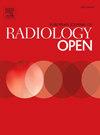缺血性脑卒中患者CTA与CTP血管造影重建客观质量参数的比较。
IF 2.9
Q3 RADIOLOGY, NUCLEAR MEDICINE & MEDICAL IMAGING
引用次数: 0
摘要
简介:CT灌注血管造影重建(CTP-AR)可用于缺血性脑卒中患者的闭塞检测。CTP-AR的客观图像质量在实施前需要进行评估,因为它可能会影响遮挡检测。在本研究中,我们旨在通过对比CT血管造影和CT灌注血管造影重建(CTP-AR)的噪声比(CNR)和信噪比(SNR)来评估客观图像质量。方法:纳入2020年9月至2021年9月期间接受CT灌注和CTA基线治疗的缺血性卒中患者。CTP- ar重建从1 mm CTP系列在动脉增强峰值。每个患者放置5个同侧和5个对侧感兴趣区(ROI)。每个ROI的衰减和标准差用于计算CNR和SNR。CTA与CTP-AR的CNR和SNR差异采用配对样本t检验。结果:共纳入195/239例患者。在同侧和对侧,CTP-AR的CNR均显著高于CTA (P P P = .68;侧:P = 点)。与CTA相比,CTP-AR在所有实质区域的信噪比均显著低于同侧和对侧;结论:ctp衍生血管造影重建的图像质量指标显示,与CTA相比,CTA的CNR更高,但非血管造影结构的信噪比更低。本文章由计算机程序翻译,如有差异,请以英文原文为准。
Comparison of objective quality parameters between CTA and CTP angiographic reconstructions in ischemic stroke patients
Introduction
CT perfusion-angiographic reconstructions (CTP-AR) may be used for occlusion detection in ischemic stroke patients. Objective image quality of CTP-AR needs to be evaluated before implementation as it may affect occlusion detection. In this study, we aimed to assess the objective image quality, by means of contrast to noise ratio (CNR) and signal to noise ratio (SNR), of both CT-angiography and CT perfusion-angiographic reconstructions (CTP-AR).
Methods
Patients with an ischemic stroke between September 2020 up to and including September 2021 who underwent both CT perfusion and CTA at baseline were included. CTP-AR was reconstructed from 1 mm CTP series at the peak arterial enhancement. Per patient, five ipsilateral and five contralateral regions of interest (ROI) were placed. Attenuation and standard deviation per ROI were used to calculate CNR and SNR. Differences in CNR and SNR between CTA and CTP-AR were tested using paired-sample t-tests.
Results
In total, 195/239 patients were included. Both on the ipsilateral and contralateral side, the CNR was significantly higher on CTP-AR compared to CTA (P < .001 and P < .001, respectively). The SNR measured in the M1 was not significantly different between CTA and CTP-AR (ipsilateral: P = .68; contralateral: P = .63). The SNR, both on the ipsilateral and contralateral side, was significantly lower on CTP-AR compared to CTA in all parenchyma regions; the caudate nucleus (P < .001), lentiform nucleus (P < .001), centrum semiovale (P < .001), and the parenchyma adjacent to the M1 (P < .001).
Conclusion
Image quality measures of CTP-derived angiographic reconstructions indicate higher CNR compared to CTA, but a lower SNR in non-angiographic structures.
求助全文
通过发布文献求助,成功后即可免费获取论文全文。
去求助
来源期刊

European Journal of Radiology Open
Medicine-Radiology, Nuclear Medicine and Imaging
CiteScore
4.10
自引率
5.00%
发文量
55
审稿时长
51 days
 求助内容:
求助内容: 应助结果提醒方式:
应助结果提醒方式:


